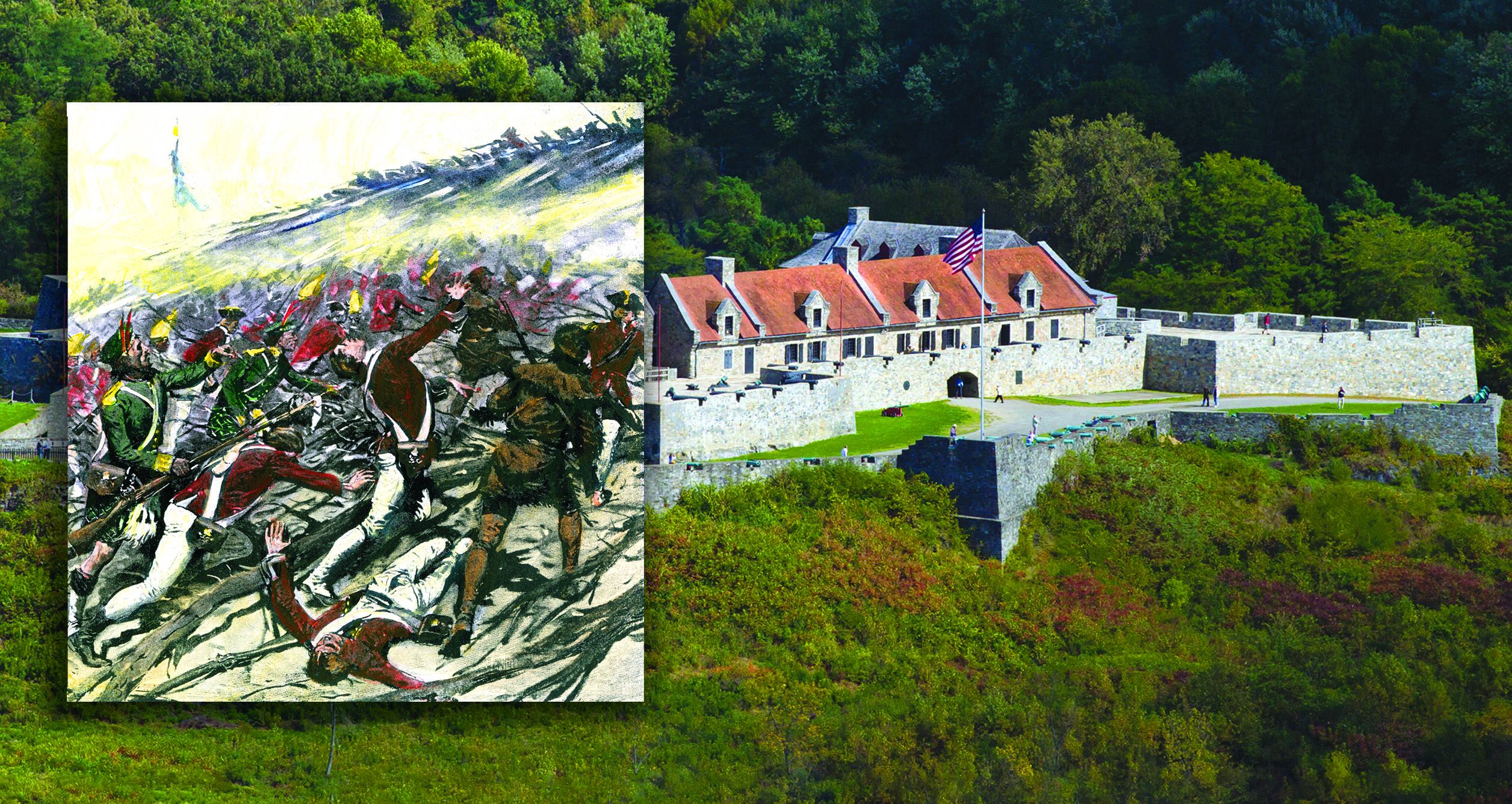Fort Ticonderoga, the scene of several 18th century military confrontations, is arguably the best known fortified site in North America. Its name derives from an Iroquois word denoting the confluence of two waterways. The French constructed the fort in disputed territory on the south end of Lake Champlain, dominating the portage along the La Chute River between Champlain and Lake George. By controlling access to Champlain, the French denied the British a water invasion route north to the Canadian capital at Quebec. Dubbed the “Key to a Continent,” the strategic site became a flash point between Britain and France during both the French and Indian and American Revolutionary wars.
Following their defeat at the 1755 Battle of Lake George, the French built the fort, naming it Carillon, likely for the sound of the La Chute rapids, which called to mind the chiming bells of a carillon. Its 7-foot-high, 14-foot-thick walls traced a centuries-old star-shaped design refined by famed French engineer Sébastien Le Prestre de Vauban. Within its four main bastions were barracks, storehouses, a powder magazine, a bakery and a sawmill. But Carillon had two critical strategic flaws. First, several nearby hills overlooked it. Second, its barracks could hold scarcely 400 garrison troops.
The 1757 French capture of Fort William Henry, on the south end of Lake George (dramatized in James Fenimore Cooper’s 1826 novel The Last of the Mohicans), prompted a British response the following year. That summer Maj. Gen. James Abercrombie approached Carillon from Lake George with more than 15,000 men—a mixture of regulars and colonial militia. Newly arrived French Brig. Gen. Louis-Joseph de Montcalm and his 3,600 soldiers hurried to enhance their defenses, adding trenches, sharpened-log abatis and other obstacles between the fort and nearby Mount Hope. On July 8 Abercrombie foolishly ordered a frontal assault against the entrenched French defenders and was repulsed with nearly 2,000 casualties.
In 1759 British Brig. Gen. Jeffrey Amherst returned with more than 11,000 troops and wrested the fort from a reduced French garrison of 400 men. Having turned the key, the British subsequently conquered Canada, ending the French and Indian War.
Despite its strategic importance, the renamed Fort Ticonderoga was in disrepair by the 1775 outset of the American Revolutionary War. Garrisoned by only 48 British soldiers, it fell to a May 10 surprise attack by the Green Mountain Boys and other militia units commanded by Cols. Ethan Allen and Benedict Arnold. Colonel Henry Knox later transported the fort’s captured heavy artillery to Boston to fortify Dorchester Heights, thus enabling Gen. George Washington to force a British withdrawal from the city in March 1776. Ticonderoga itself became a launching ground for the disastrous American invasion of Quebec. British forces chased the would-be invaders back to Ticonderoga, reaching the fort in June 1776. While its defenses held, the British managed to defeat American gunboats on Lake Champlain during the Battle of Valcour Island in October before withdrawing to Canada for the winter.
Washington believed an invasion from Canada unlikely and, regardless, considered the fort impregnable. Imagine the surprise, then, of Maj. Gen. Arthur St. Clair and his 2,000-man garrison on the sudden appearance in late June 1777 of British Lt. Gen. John Burgoyne at the head of 8,000 troops, who occupied high ground at Mount Defiance. Rather than face a costly siege, St. Clair abandoned Ticonderoga to the British on July 5. Removed from his command, the maligned general demanded a court-martial and was exonerated. In September 1777 Col. John Brown and 500 Massachusetts militiamen sought to retake the fort from some 100 British defenders, but the Americans were discovered and driven off by reinforcements. In the wake of Burgoyne’s October 1777 defeat at Saratoga, the fort lost its strategic value and was ultimately abandoned.
After the war the fort fell into neglect and was stripped by area residents seeking construction materials. In 1820 horticulturist William Ferris Pell bought the property, and his family later had the fort restored for the tourist trade. Since 1931 a private foundation has operated a museum and research center on the site. Boasting one of the most significant 18th century military history collections in North America, Ticonderoga also offers exhibitions, historical re-enactments, special tours and river cruises, though the COVID-19 shutdown has curtailed operations. MH
This article appeared in the September 2020 issue of Military History magazine. For more stories, subscribe here and visit us on Facebook:






